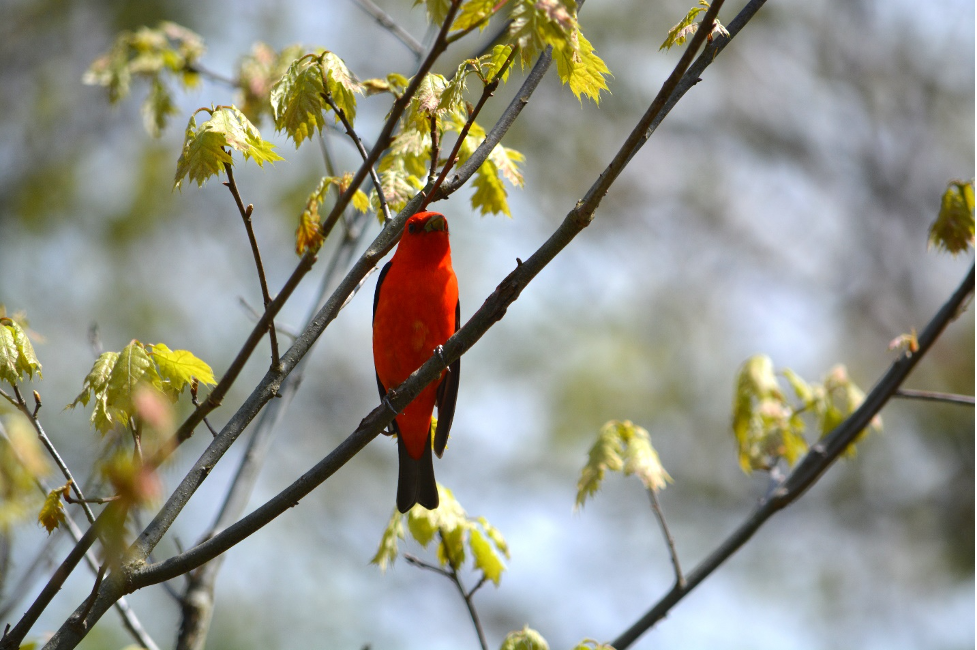One of the best ways to attract birds to your yard is to plant native trees and shrubs.
INTRO
A common question we get from landowners is “what can I do to attract birds to my property?” And while the answer may vary depending on what kinds of birds you’re hoping to see, one strategy tends to be effective: provide them with food by way of planting native trees and shrubs.
Cardinal perched in an American Holly, one of several native plants that produce berries in the winter when most food is scarce.
WHY NATIVE PLANTS ARE ATTRACTIVE TO BIRDS
Native birds are bound to a food web that is facilitated by native plants. Over evolutionary time, each bird species became associated with particular native plants and their ability to provide food in the form of fruit and insects.
Unfortunately, when we build our homes, we tend to destroy native vegetation and replace what remains with non-native ornamental plants. Non-native plants offer little in the way of attracting insects or producing nutritious fruit. Therefore, one of the best ways to bring birds to your property is to reestablish native trees and shrubs that 1) are attractive to insects, and 2) produce favored fruit. Some trees and shrubs are better than others with respect to both, so let’s delve into a few.
MORE NATIVE TREES = MORE CATERPILLARS = MORE BIRDS
Caterpillars are a staple in the diets of many songbirds during the warmer months. This is due to the fact that most caterpillars are easily digestible and nutritious for baby birds. Peer reviewed research has established that oaks, willows, and cherries are among the most attractive tree types for caterpillars. Consequently, planting a variety of native oaks, willows, and cherries on your property will attract caterpillars, which in turn, will bring in the birds. Here are a few caterpillar and bird friendly tree species to consider planting on your property:
White Oak (Quercus alba) – a large, slow growing, and long-lived oak species. White Oak is capable of growing in a wide variety of environments. In addition to attracting insects in the summer, they produce acorns in the fall, which are attractive to blue jays, turkey, and grouse.
Black Willow (Salix nigra) – a large, fast growing tree species, typically found along streams and bodies of water. If you have a waterway or a pond on your property, this may be an excellent species to plant.
Black Cherry (Prunus serotina) – a tall, ecologically important tree species found in a variety of habitats. Black Cherries are beneficial for birds in more ways than one: not only are they attractive to caterpillars, they produces fruit that birds love as well.

Scarlet Tanager perched in an oak tree, scanning for insects
NATIVE FRUIT-BEARING SHRUBS PROVIDE MUCH NEEDED ENERGY
Once the breeding season concludes, many birds turn their attention to nutritious fruit. This includes the birds in need of energy for the fall migration, as well as those who stick around during the colder months. There are a number of native, fruit-bearing shrubs that are favored by birds. Here are a few worth your consideration:
- Eastern Red Cedar (Juniperus virginiana) – a hardy evergreen tree whose blue-green berry-like cones are favored by one of Pennsylvania’s most attractive bird species: the Cedar Waxwing (pictured below). It’s worth noting that only female Eastern Red Cedars produce the berry-like cones.
- Shadbush (Amelanchier canadensis) – a tall deciduous shrub or understory tree with purple-blue berries that are absolutely loved by dozens of bird species. It’s typically found in wet areas, though it is capable of growing in a variety of conditions.
- Elderberry (Sambucus canadensis) – a small deciduous shrub that is among the most attractive fruit-bearing plants for birds. Their black berries are present in late summer and fall, so they provide birds with a great head start heading into winter.
- Winterberry (Ilex verticillata) – a small shrub whose red berries are consumed by a number of bird species. It’s aptly named, in that their berries persist in the winter, so long as birds haven’t eaten them all. And similar to the Eastern Red Cedar, only female Winterberries produce fruit.

Cedar Waxwing foraging in an Eastern Red Cedar
It’s worth noting that the relationships between these native plants and our native birds and insects are more complex than can be summed up in this quick guide. For instance, there is plenty of overlap between plants that attract insects and those who produce fruit. Shadbush produces fruit that birds love, but they also produce flowers that are attractive to insects. Another example is that in addition to supplying food, native plants provide birds with shelter. Overall, having native trees and shrubs in your yard offers birds multiple incentives to stop by.
Chances are, you already have some native trees or shrubs in your yard that the birds love. The key is supplementing those with an assortment of others. You can follow the link at the bottom of this page to see where native plants are sold near you. We hope this guide provides you with inspiration and a starting point to join us in creating better habitat for birds, which is one step in our efforts to preserve and protect our natural heritage. Thanks for reading, and happy planting!
Sebastian Harris, Conservation Easement Steward
WHERE TO ACQUIRE NATIVE PLANTS IN PENNSYLVANIA: